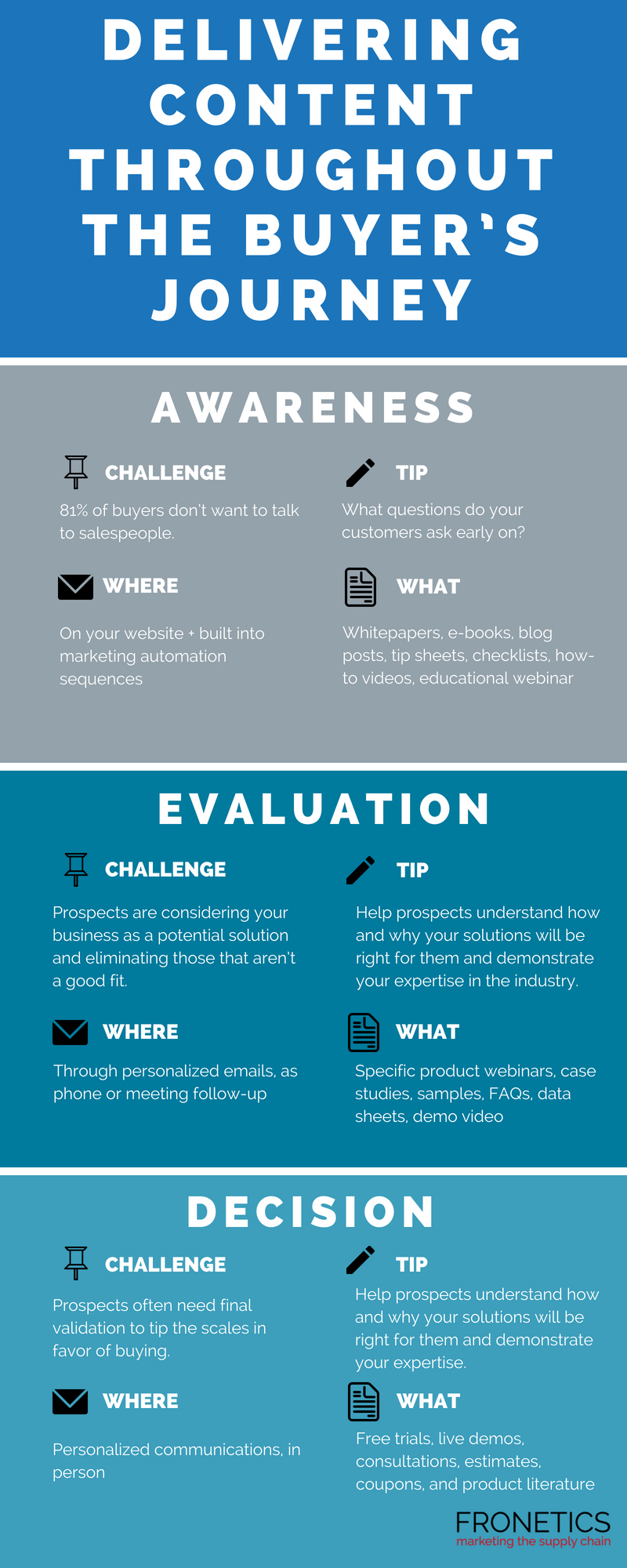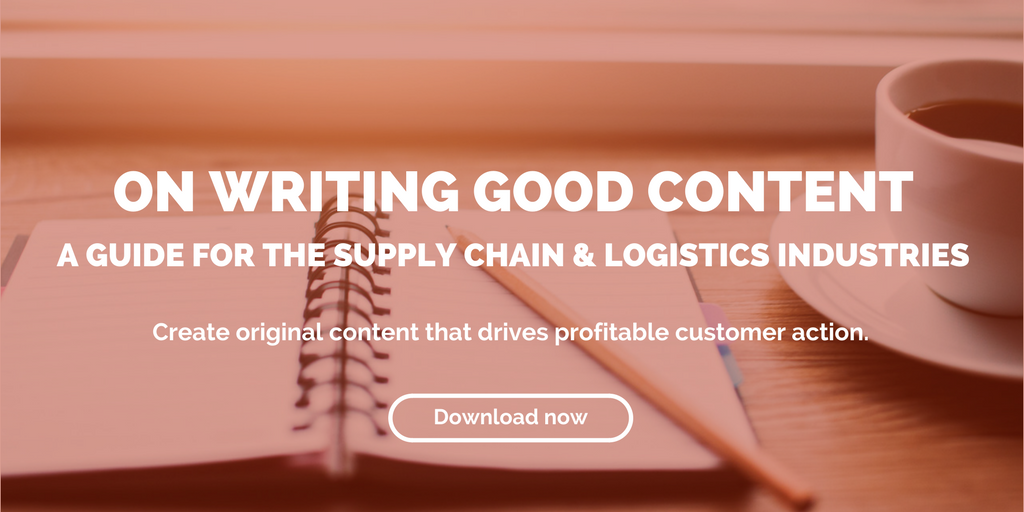
by Fronetics | Aug 27, 2018 | Blog, Content Marketing, Logistics, Marketing, Social Media, Strategy, Supply Chain
Repurposed and repackaged, your existing content is a valuable asset for your sales force throughout the buyer’s journey.
If you’re a supply chain marketing professional, it’s likely that you spend a tremendous portion of your day researching, creating, packaging, and disseminating content. Your hard work is all about growing brand awareness and building your reputation as a trusted industry thought-leader — all with the goal of having that work eventually convert leads.
But, consider this: When it comes to engaging prospects and clients, only 20% of salespeople actually use content. When we know that potential buyers are far more willing to engage with someone offering them information and insight, why are B2B businesses abandoning content as soon as prospects are handed over to sales?
B2B buyers prefer content throughout the buying journey
According to DemandGen’s 2018 Content Preferences Survey Report, “Buyers are becoming increasingly more selective in the content they are consuming,” relying more on “trustworthy sources, industry influencers, and their peers to educate themselves.” And furthermore, 88% of those survey respondents want less focus on product specifics and more on the value that product can bring to their business.
[bctt tweet=”Buyers are becoming increasingly more selective in the content they are consuming, relying more on trustworthy sources, industry influencers, and their peers to educate themselves.” username=”Fronetics”]
And on the other side of that coin, according to HubSpot writer and marketing expert Bethany Cartwright, sales reps spend about 15% of their day leaving voicemails, and only about 20% of all sales emails are ever opened. “This means 80-85% of sales outreach efforts are going unnoticed by those prospects you’ve worked so hard to capture with content,” writes Cartwright.
It’s time to start leveraging your content throughout the buyer’s journey by arming your sales force with content. Before you panic at the idea of creating reams of new content, take a breath. It’s more than likely that you can repurpose your existing content, optimized to give your sales force the tools they need to close deals.
So how do you go about repurposing your content and giving your sales force the best possible tools with which to convert prospects to buyers? Web Profits co-founder and author Sujan Patel suggests “mapping content generated by your marketing team to each stage of your customer’s buying journey.” We’ve created the infographic below to help you optimize content for each of the three stages of the buyer’s journey.
Infographic: Delivering content throughout the buyer’s journey

(Made with Canva)
Related posts:


by Fronetics | Feb 13, 2018 | Blog, Content Marketing, Logistics, Marketing, Supply Chain
Here are three tips for writing pillar content that will help structure your posts, attract leads and gain better page rankings.
In case you missed our series on writing for SEO, pillar content is a highly effective way to define your brand, drive traffic, and convert website visitors to leads. But in order to be effective, these pages should be strategically designed to do their proper job in telling search engines what your site is all about.
Before we go further, let’s take a step back and talk about exactly what pillar content is. As search engines adjust their algorithms to favor topic-based content, savvy marketers are turning to topic clusters to structure their content.
“This method uses a single pillar page as the main hub of content for a given topic. All of your content assets related to that topic link back to the pillar page,” explains HubSpot blogger Amanda Zantal-Wiener.
Need some ideas for writing and structuring effective pillar content? Here are three tips to get you started.
3 tips for writing pillar content
1) Start thinking about your site differently.
Not so long ago, SEO optimization was all about keywords. But search engines are changing. As their algorithms get more sophisticated, they look for websites that can provide depth and breadth on a particular topic. That means topic-based content wins you better page rank. It’s time to start thinking about your site as a collection of topics rather than a collection of keywords.
2) Consider your core audience.
“Think about the top interests and challenges of your core audience personas to give you ideas for pillar page content,” says HubSpot blogger Sophia Bernazzani.
Good content marketing is all about cultivating your reputation as a trusted resource for your audience, and pillar pages are no exception. Chose topics that answer the needs of your target audience. Topics should be broad enough to be able to generate multiple related blog posts, but narrow enough that you can cover all related content on a single pillar page.
3) Your content is about answering questions.
“Pillar pages should answer any question or query a searcher might have about a topic — which will make them want to click on your pillar page when they enter a Google search term that your page ranks for,” writes Bernazzani. The goal is to draw site visitors with savvy pillar content, and let them explore all content in your topic cluster.
Related posts:


by Fronetics | May 30, 2016 | Blog, Content Marketing, Marketing, Supply Chain

Fronetics’ new guide offers a road map for content production that will help grow your business.
Content marketing is one of the most effective ways to generate leads and grow your business. Yet only 30% of B2B marketers define their content marketing programs as successful. Time and again, they cite producing effective content as their main challenge.
Consider this: 27 million pieces of content are shared every day, and most of it is crap. For your content to be effective — meaning your content attracts your target audience and drives profitable customer action — it must stand out, really stand out, among the masses.
Fronetics has developed a guide to help companies in the logistics and supply chain industries create effective content. On Writing Good Content : A Guide for the Logistics and Supply Chain Industries provides a road map to producing content that generates leads and drives new business. With this guide, you will:
- Learn the basic principles of good content
- Identify potential content creators within your organization
- Brainstorm ideas for original content
- Receive writing prompts that will get you started producing the kind of content that will resonate best with your target audience
Start creating effective content today by downloading the free guide below.

Related posts:

by Fronetics | Nov 4, 2015 | Blog, Content Marketing, Marketing, Supply Chain
3 things supply chain hiring managers should look for when hiring a copywriter.
Since 94% of domestic B2B buyers conduct research online to make purchase decisions, maintaining high-quality content on your company’s website is crucial for attracting new business. But who has time for web upkeep, much less for the generation of new blog posts, emails, and various other content? Enter the copywriter.
An effective copywriter can help drive consumers to your website, convince them of the quality of your products/services, and ultimately help convert those leads into customers. A lot of writers can do one of these functions. The gold standard, of course, is a copywriter with a proven track record in all three functions.
How do you know if a copywriter will be effective for your business? Here are a few specific skills and experiences supply chain hiring managers should look for in a potential hire:
Someone who understands SEO.
An SEO-savvy copywriter can impact your business by increasing the number of visitors (i.e., potential customers) to your site. That’s because 77% of today’s buyers use Google to research information about products.
A copywriter trained in search engine optimization (SEO) knows how to write and format your site so it gets prioritized by Google in web queries for your products. Three of four people will click on the top five search results. So the closer you can be to those top five results, the better your chances at driving a buyer to your site. That’s a crucial first step in converting that lead into a new customer.
Look for SEO training or experience on a potential copywriter’s resume. And ask for any metrics illustrating how his/her search-engine-optimized content has increased organic traffic to a client’s website. A copywriter who understands SEO can help achieve the same result for you over time.
Someone who understands branding.
Sure, it’s great if you can find a copywriter with experience in the supply chain — the vocabulary and industry knowledge are already in place. But, likely, a solid writer who has developed content for a variety of industries has the technical skills and resourcefulness to get up to speed quickly.
Consider the value of a candidate who also has marketing writing and branding experience. This person has the know-how to create content driven by your business objectives and a mind for strategy that can promote your image among consumers and other businesses.
A 2015 global study on B2B branding has shown its positive impact on the perceived quality of a product and creation of new market opportunities. Branding instills confidence and trust among consumers.
The marketing copywriter can craft a consistent, compelling brand narrative across all of your digital channels. That means your website, blog posts, white papers, social media, emails, etc., will work together to solidify and enhance your business’s reputation in the marketplace, which will serve you beyond any individual campaign.
Someone who understands user experience.
User experience plays a vital role in conversion: the more positive the customer’s interaction with your business, the more motivated s/he will be to purchase from you. Additionally, Gartner Research estimates that by 2020 customers will manage 85% of their relationship without talking to a human. That means your web content will bear most of the user-experience burden.
A copywriter who understands user experience anticipates what buyers are seeking at any given point on your website and adjusts the copy so that the answer is clear and easy to find. Paragraphs of dense, technical copy on a product page could easily turn a buyer away, for example. A well-placed, well-written call-to-action, however, could lead to a purchase.
To find a copywriter who understands user experience, look for content that is not only polished, but also helpful, persuasive, and, above all, accessible. Writing samples should reflect where in the sales cycle a user would encounter it. That candidate could play a vital role in helping you convert leads into customers.
Hiring a copywriter represents an opportunity to bring someone on board who can do more than produce content: they can help achieve your business goals.
Related posts:


by Fronetics | Jan 1, 2015 | Blog, Content Marketing, Marketing, Strategy, Talent

93% of B2B marketers use content marketing. However, less than half (42%) of B2B marketers say that they are effective at content marketing. One of the reasons these marketers are ineffective: bad content.
All content is not created equal. There is good content. There is bad content. Good content drives profitable customer action. Bad content does not drive profitable customer action.
You need good content.
What is good content? Here are 3 elements of good content:
1. Good content is original
Good content is content that is unique. It is not content that is copied and pasted. It is not regurgitated content. Not only is original content SEO friendly, original content is customer-friendly. 70% of consumers prefer to get to know a company through original articles.
2. Good content stands out
There are more than 27 million pieces of content shared each day. If you want your content to get lost, create bad content. If you want content that stands out you need content that differs from that of the rest of the pack. You can make content stand out by using winning headlines, graphics, images, infographics, and with great writing.
3. Good content attracts and engages current and prospective customers
Every single piece of content that makes it onto your website and blog needs to be content that is created with your current and prospective customers in mind.
Content that attracts and engages is not a sales pitch. Rather, it is content that communicates valuable information to customers and prospects so that they have the knowledge to make better informed decisions. Moreover, it is content that establishes your business as a reliable source of knowledge – as the thought-leader within the industry.
Good content excites customers and prospects and makes them want to reach out to you.
You get what you pay for
Content creation takes time. However, time is often hard to come by. 69% of content marketers feel a lack of time is their greatest challenge. Moreover, almost 50% of marketers struggle with producing enough content, and producing content that engages.
Faced with constraints of time and volume, quality often takes a hit. In some cases the company itself creates and distributes content of poor quality. In other cases, the company chooses to outsource content creation, but does not do their due diligence with respect to the outsource partner and the quality of content that is created.
Good content is not inexpensive. That being said, good content is worth its weight in gold. This is not something I just say, this is something I know. I gave several low cost content options a try.
I began by conducting a search for companies that offered low-cost content (content that costs less than $20 per blog post). I then narrowed the field down even more by researching which of these companies had the highest rankings and customer satisfaction rates. I then selected two companies and decided to give it a go.
The results were dismal. The content was not good content.
If you want content that is good content and will drive profitable results you need to invest. You need to either invest in someone in-house, or you need to conduct your due diligence and find an outsource partner that can create good content for your company.
Interested in learning more about content? Check out these articles:
Or simply,













